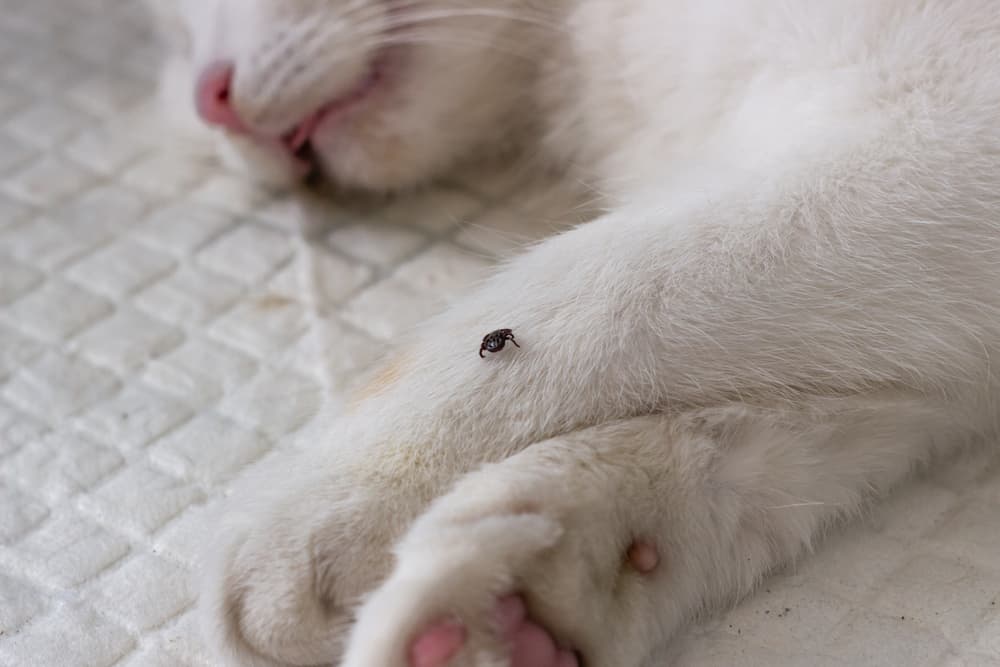Can Cats Get Lyme Disease?

Lyme disease, caused by the bacteria Borrelia burgdorferi, is a tick-borne disease that has been found in all 48 states in the continental United States.
Although Lyme disease can affect dogs and cats, it is much more common in dogs than cats. Lyme disease in cats has been observed only in a laboratory setting and not in the natural environment.
If you’re wondering if a cat can get Lyme disease, the short answer is: yes, but it is unlikely. Although Lyme disease is exceedingly rare in cats, it’s still worth learning more about this tick-borne disease.
Can Cats Get Lyme Disease?

Cats can get Lyme disease, but the chances of a cat—indoor or feral—being affected by the disease are close to zero.
Lyme disease is transmitted by the deer tick (Ixodes scapularis or Ixodes pacificus), typically in the spring and fall. Nymphs (baby ticks) and adult female deer ticks are the primary spreaders of the disease.
Deer ticks become infected when they feed off of wildlife infected with B. burgdorferi. The bacteria enters the tick’s body during a feeding.
Ticks like to perch on stalks of grass. Rather than jump onto their hosts, ticks wait until an unwitting host walks by. The tick then crawls onto the host’s skin.
Theoretically, if a deer tick landed on a cat, it would start feeding and transmit B. burgdorferi through its saliva onto the cat’s skin. This transmission process would take about 24 to 48 hours. The bacteria would replicate on the skin, then move into the cat’s tissues, including the joints and nervous system, where it would stay hidden from the immune system.
Even for strictly indoor cats, a deer tick could find its way inside by hitching a ride on a person or dog who’s just been outside. That deer tick could eventually crawl onto the cat’s skin.
However, cats’ fastidious grooming habits work in their favor regarding Lyme disease. Even if a deer tick did land on your cat, your cat’s grooming would probably remove the tick before it began transmitting the bacteria.
Symptoms of Lyme Disease in Cats

Cats with Lyme disease are frequently asymptomatic. If a cat does have clinical signs, these signs will be similar to those seen in dogs with Lyme disease:
- Fever
- Fatigue
- Loss of appetite
- Difficulty breathing
- Shifting leg lameness (shifting from one leg to the other because of pain)
Severe Lyme disease can damage the kidneys and cause symptoms like vomiting, limb swelling, and weight loss.
A telltale sign of Lyme disease in people is a ‘bull’s eye’ rash at the bite site, but cats and dogs rarely develop this rash.
Symptoms of Lyme disease in cats don’t show up until several weeks after the tick bite. If a deer tick has bitten your cat, and the tick stayed on long enough to transmit B. burgdorferi, you would have to wait for at least several weeks to see any signs of the disease.
Ticks on Cats: What to Do

Check your cat’s skin regularly for ticks, especially if your cat spends any amount of time outside. Promptly remove any tick you see to minimize the chances of disease transmission. Here are the steps to safely remove a tick from a cat:
Step 1: Gather tick-removing supplies: rubbing alcohol, a glass jar, a pair of disposable gloves, a pair of tweezers, and triple-antibiotic ointment.
Step 2: Pour rubbing alcohol into the jar and clean the tweezers with some rubbing alcohol.
Step 3: Put on a pair of gloves.
Step 4: Pull back your cat’s fur as much as possible to get a good view of the tick.
Step 5: Use the tweezers to grasp the tick’s head. Do not squeeze or twist!
Step 6: Firmly pull up and remove the tick from your cat’s skin.
Step 7: Place the tick in the jar of rubbing alcohol to kill it.
Step 8: Throw away your gloves and wash your hands.
Step 9: Wash the bite site with pet-safe soap and water and then monitor for signs of infection.
Contact your veterinarian after you have removed the tick. Your veterinarian may advise you to submit the tick to a veterinary diagnostic laboratory for additional testing to determine the diseases the tick carries.
Although signs of Lyme disease take weeks to appear after a tick bite, continue monitoring your cat after removing the tick. Contact your veterinarian if your cat shows any signs of Lyme disease.
Diagnosing Lyme Disease in Cats

Veterinarians diagnose Lyme disease in cats by knowing a cat’s history of tick exposure, performing basic laboratory tests (blood work, urinalysis, X-rays), and ruling out other diseases that could be causing Lyme disease-related symptoms. Veterinarians may also test a sample of joint fluid for B. burgdorferi.
A blood test is available that detects Lyme disease. However, a positive test result would not show up until several weeks after the tick bite.
If you submitted the tick for testing, those results would help determine whether your cat has Lyme disease.
Treatment for Lyme Disease in Cats

Lyme disease in cats is treated with the antibiotic doxycycline, which works quickly and is very effective against the disease. When treated early, cats with Lyme disease have a good prognosis.
Lyme disease that is not treated early or left untreated can cause permanent tissue damage, so early treatment provides the best chance of recovery.
Medications to Treat Lyme Disease in Cats
Doxycycline is typically given for a 30-day treatment course. Although this antibiotic is effective, it does have some drawbacks. For example, not all cats can tolerate doxycycline. Also, because B. burgdorferi likes to hide inside the tissues, multiple rounds of doxycycline may be needed to clear the body of the bacteria.
Doxycycline tablets can cause esophageal strictures that narrow the esophagus and make swallowing difficult. Veterinarians often prescribe liquid doxycycline to avoid this problem.
Pain medication is recommended if a cat has joint pain.
If a cat has severe Lyme disease, additional medications, such as intravenous fluid therapy and kidney medications, may be needed.
Cost to Treat Lyme Disease in Cats
Diagnosing and treating Lyme disease has varied costs. It may cost several hundred dollars to complete the diagnostic testing for the disease, especially if the tick is submitted for testing at a veterinary diagnostic laboratory.
The cost of medications varies, but doxycycline and common pain medications are usually not very expensive. Treatment costs can jump significantly for cats that require hospitalization because of severe Lyme disease.
Your veterinarian will determine the exact costs of treating your cat.
Preventing Lyme Disease in Cats

Monthly tick prevention is the best way to prevent Lyme disease in cats. A monthly topical tick preventative, given every month throughout the year, will provide the best tick prevention for your cat. Remember that tick prevention is still important for indoor cats.
Other prevention strategies include checking your cat’s skin for ticks regularly (and removing any ticks that you see) and keeping your grass trimmed. Of course, keeping your cat indoors as much as possible will minimize the chances of a tick crawling onto your cat.
Lyme Disease in Cats: Bringing It Together
Because Lyme disease is so rare in cats, this disease is not something that needs to be high on your list of concerns as a cat owner. However, ticks do carry other diseases that are much more likely to pass to cats, such as cytauxzoonosis. Remain diligent about practicing tick prevention strategies and contact your veterinarian if your cat has been bitten by a tick and shows signs of illness.









